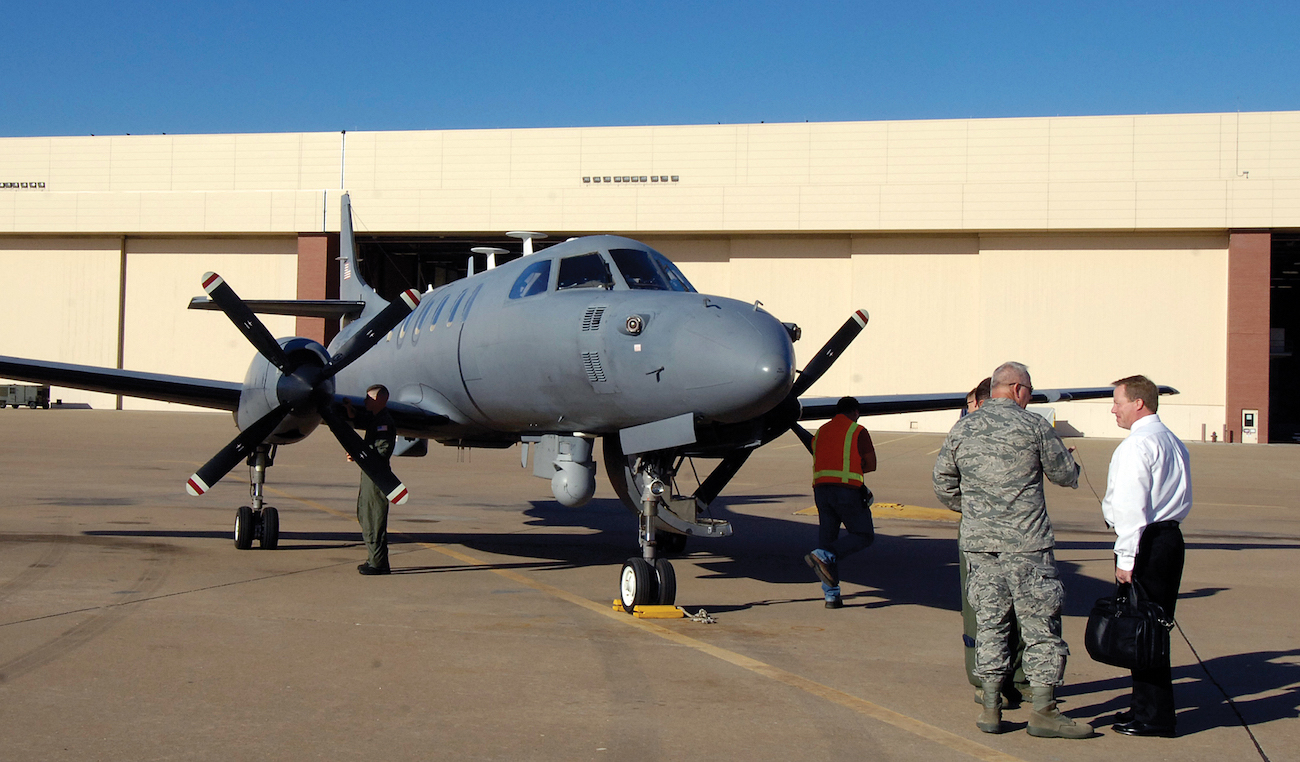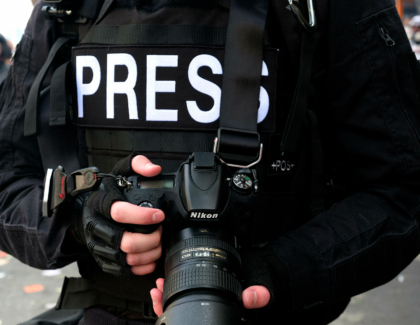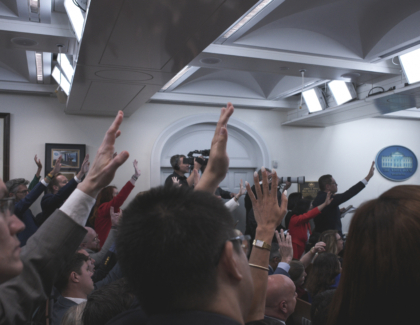Sign up for the daily CJR newsletter.
This story is being co-published with BuzzFeed News.
A secret spy plane operated by the US Marshals hunted drug cartel kingpins in Mexico. A military contractor that tracks terrorists in Africa is also flying surveillance aircraft over US cities. In two stories published last week, BuzzFeed News revealed the activities of aircraft that their operators didn’t want to discuss.
These discoveries came not from tip-offs from anonymous sources, but by training a computer to recognize known spy planes, then setting it loose on large quantities of flight-tracking data compiled by the website Flightradar24.
Here’s how we did it.
Surveillance aircraft often keep a low profile: The FBI, for example, registers its planes to fictitious companies to mask their true identity.
So BuzzFeed News trained a computer to find them by letting a machine-learning algorithm sift for planes with flight patterns that resembled those operated by the FBI and the Department of Homeland Security. Last year, we reported on aerial surveillance by these planes, mapping thousands of flights over more than four months from mid-August to the end of December 2015.
First we made a series of calculations to describe the flight characteristics of almost 20,000 planes in the four months of Flightradar24 data: their turning rates, speeds and altitudes flown, the areas of rectangles drawn around each flight path, and the flights’ durations. We also included information on the manufacturer and model of each aircraft, and the four-digit squawk codes emitted by the planes’ transponders.
Then we turned to an algorithm called the “random forest,” training it to distinguish between the characteristics of two groups of planes: almost 100 previously identified FBI and DHS planes, and 500 randomly selected aircraft.
The random forest algorithm makes its own decisions about which aspects of the data are most important. But not surprisingly, given that spy planes tend to fly in tight circles, it put most weight on the planes’ turning rates. We then used its model to assess all of the planes, calculating a probability that each aircraft was a match for those flown by the FBI and DHS.
(See here for details of the machine learning, and notes on the candidate planes it identified.)
The algorithm was not infallible: Among other candidates, it flagged several skydiving operations that circled in a relatively small area, much like a typical surveillance aircraft. But as an initial screen for candidate spy planes, it proved very effective. In addition to aircraft operated by the US Marshals and the military contractor Acorn Growth Companies, covered in our previous stories, it highlighted a variety of planes flown by law enforcement, and by the military and its contractors.
We’ve been watching these aircraft, and others registered to the same organizations, ever since. Here are five of the most intriguing examples.
1. State and local cops, featuring the Palm Beach County Sheriff’s secret plane
Some of the algorithm’s top matches were aircraft operated by state and local law enforcement: The top 20 candidates included aircraft registered to the cities of Mesa and Phoenix in Arizona, the sheriffs of Orange and Los Angeles counties in California, and the Ohio State Highway Patrol. In July of last year, the Ohio plane showed up above Cleveland during the Republican National Convention, where it watched for “suspicious persons in immediate proximity to secure areas,” a patrol spokesperson told BuzzFeed News at the time.
The algorithm also highlighted a plane registered to a company called Five Point Aerial Survey, which seems to be a front for the Palm Beach County Sheriff’s Office in Florida. The fake company’s name recalls the sheriff’s badge, and the plane’s registration number, ending in the letters “RB,” is consistent with other planes registered openly by the office. The Palm Beach County Sheriff has reserved other registration numbers in the same format, giving an address for an outfit called Eagle Eye Investigations.
The Five Point plane carries a surveillance camera and augmented-reality system, able to superimpose information onto live video, which is often used on law enforcement planes. But Teri Barbera, the sheriff’s director of media relations, would neither confirm nor deny that the Five Point aircraft belonged to the sheriff’s office — which denied a request for documents mentioning the plane, citing an exemption from state records law covering law enforcement surveillance and undercover personnel.
Over the past couple of years, the Five Point plane has regularly circled locations around Palm Beach and patrolled off its coast.

Peter Aldhous / BuzzFeed News / Via flightradar24.com Flights by an SRT plane over Florida, January 2015 to July 2017.
2. Eavesdropping at the border: Global Geo Mapping
We weren’t expecting to find covertly registered DHS aircraft, given that the department registers dozens of surveillance planes quite openly. But our algorithm flagged a plane registered to Global Geo Mapping that Federal Aviation Administration documents revealed is actually a front for US Customs and Border Protection, part of the DHS. Global Geo Mapping gives an address at the Kirtland Air Force Base in Albuquerque, New Mexico, and its aircraft mostly patrol along the southern border.

Peter Aldhous / BuzzFeed News / Via flightradar24.com
Flights by Global Geo Mapping planes near the US–Mexico border, January 2015 to July 2017
FAA documents describing modifications to these planes reveal the installation of surveillance cameras and equipment for “LETC,” which stands for Law Enforcement Technical Collection. Operated from fixed listening stations along the border, as well as from DHS aircraft, LETC involves federal agents listening in on radio communications, such as two-way radios, to detect suspicious chatter.
Christiana Coleman, a spokesperson for the CBP, told BuzzFeed News by email that the aircraft do not carry equipment to track cell phones — which requires a warrant under DHS rules that also prohibit eavesdropping on conversations. But the federal government is able to intercept other radio signals without a warrant. So if you use a walkie-talkie near the border with Mexico, there is a chance that a CBP agent flying overhead is listening.
A privacy assessment published in 2014 noted: “LETC users may listen to or record radio frequency communications between individuals engaged in activities with no law enforcement nexus.” Agents are allowed to retain an audio recording and keep notes only if the conversation relates to “ongoing law enforcement activity,” however.
The FAA registration documents for Global Geo Mapping included a contact phone number that’s actually a spoof: It’s owned by Universal Studios and used in movies.
We also found a second front for the DHS called Midwest Aerial Imaging, which flieshelicopters that usually watch over Chicago, Detroit, and other Midwestern cities. Its choppers have also provided security for major events, showing up when BuzzFeed News tracked the surveillance aircraft that monitored the Republican National Convention in Cleveland in July 2016, and President Donald Trump’s inauguration in January of this year.
3. The military: Air Force Special Ops, Big Safari, and Air Cerberus
Most military aircraft don’t have civilian registrations and aren’t recorded on commercial flight-tracking websites. But a number of military spy planes nevertheless showed up in the Flightradar24 data.
We were initially baffled by some of the aircraft the algorithm flagged: They included one plane that identified itself as a powered parachute, and another as a small drone owned by a photographer.
The location of their circling paths, and some digging into the history of the aircraft registrations, solved the mystery. They were U-28A spy planes operated by US Air Force Special Operations Command from its base at Hurlburt Field in the Florida Panhandle. These planes are modified from civilian Pilatus PC-12 aircraft by the Sierra Nevada Corporation, a major defense contractor. Flying for the military, some were still transmitting the identifying code linked to their old civilian registration numbers, which had since been recycled.

Peter Aldhous / BuzzFeed News / Via flightradar24.com
Flights by US Air Force Special Operations Command over the Florida Panhandle, January 2015 to July 2017. Military bases are shown in pink.
Another aircraft in the algorithm’s haul belonged to the Air Force’s 645th Aeronautical Engineering Systems Group. Known as “Big Safari,” this secretive unit is based at the Wright-Patterson Air Force Base in Ohio, and has run special operations overseas. At home, it flies a C-146A Wolfhound aircraft that is a test bed for electronic surveillance equipment. We saw this plane circling over Raleigh and Fayetteville in North Carolina (near the Fort Bragg Army base), and near Denver.
Widening the search to other aircraft registered to Big Safari, we spotted a Pilatus PC-12 that mostly circled near Denver. This appears to be one of 18 planes prepared by the Sierra Nevada Corporation for transfer to the Afghan army’s Special Mission Wing to spy on Taliban insurgents.
Big Safari declined to comment in detail on its operations. “To preserve our technical advantage over any adversary, we do not discuss specific capabilities or testing,” Emily Grabowski, a spokesperson for the US Air Force, told BuzzFeed News by email.
Across California and Nevada, a plane registered to a company called Air Cerberus, formerly a front for the Air National Guard, circled multiple locations. This was an RC-26 surveillance aircraft, part of a nationwide fleet that has been used to support federal, state, and local law enforcement counter-drug operations since the late 1990s. The aircraft are also used in military training and to help combat wildfires, using thermal imaging cameras to look for hot spots.
Seven RC-26 planes linked to Air Cerberus had their civilian registrations canceled in May and June of this year. They had actually been switched to the military registration some years before, Michael Houk, a spokesperson for the Air National Guard, told BuzzFeed News by email.
4. The drug cops: Silver Creek Aviation and Chaparral Air Group
After the DHS and the FBI, the largest fleet of federal law enforcement aircraft belongs to the Drug Enforcement Administration. The DEA is also the federal agency that has made the greatest effort to hide its planes from public view. According to records obtained by BuzzFeed News under a Freedom of Information Act request, in 2014 the DEA requested that the FAA remove 95 of its aircraft — mostly registered to front companies — from the feed of air traffic control data provided to commercial flight-tracking websites, including Flightradar24.
Nevertheless, a few DEA planes have slipped through the net, and two registered to the front companies Chaparral Air Group and Silver Creek Aviation Services were flagged by our algorithm in the Flightradar24 data. Other DEA aircraft still show up on ADS-B Exchange, a website that is entirely crowdsourced by aviation enthusiasts detecting aircraft transponder signals using their own antennae. ADS-B Exchange does not filter its display using the FAA’s list of blocked aircraft, and its data revealed that DEA planes and helicopters have been watching over many US cities over the past year.
The DEA declined to comment on its aviation operations. “The DEA aviation section supports numerous operations that are law enforcement sensitive,” spokesperson Melvin Patterson told BuzzFeed News by email. “Sharing such information would allow criminals to use this to their advantage.”
5. The contractors: where things got weird
Our algorithm also flagged a number of contractors that either fly or modify planes for the military, or make equipment that military spy planes use for surveillance. These included a plane owned by the Sierra Nevada Corporation, and another owned by a firmthat helps train combat pilots.
Things took a strange turn, however, when we contacted a company called SciFly, based in San Diego. The company was contracted by Naval Special Warfare Command — which includes the Navy SEALs — to support military training, and its plane circled repeatedly over locations throughout the San Francisco Bay Area in October 2015.

Peter Aldhous / BuzzFeed News / Via flightradar24.com
Flights by SciFly in the San Francisco Bay Area, October 2015.
When BuzzFeed News approached SciFly’s CEO, Eddie Kisfaludy, he denied the flights were conducted for the military, and said the plane had been watching harbor porpoises. It was a pilot project for planned studies of the endangered vaquita—the world’s rarest marine mammal, found only in the northern reaches of Mexico’s Gulf of California—Kisfaludy said.
Buzzfeed News verified that SciFly was collaborating with the Marine Mammal Center, just north of San Francisco, on the porpoise project. But the center said that the dates didn’t match, and Kisfaludy’s explanation for these particular flights didn’t make much sense, as most of the circling was over land.
US Special Operations Command, which oversees the military’s special forces units, later confirmed that both the October 2015 San Francisco Bay flights and circling by SciFly’s plane over the island of Santa Catalina off southern California in April 2016 were run to support naval special operations training.
Another company, the SRT Group, reacted indignantly when asked about regular circling by one of its aircraft to the north of its headquarters in Davie, Florida, near Fort Lauderdale.* Photos of the plane appear online, on a page promoting surveillance and other services offered by SRT Aviation. But it is not a surveillance aircraft, Vincent Costagliola, SRT’s vice president for law enforcement technology, told BuzzFeed News by email. “Looking ahead, your email gives the impression that you may try to mischaracterize us, and may also involve an attempt to obtain our proprietary information,” he added.
Costagliola wrote that the aircraft was used to test the wireless networking equipment that SRT manufactures. No matter what product is on board, he wrote, the plane “is not used to collect or store any data on any person.”

Peter Aldhous / BuzzFeed News / Via flightradar24.com
Flights by an SRT plane over Florida, January 2015 to July 2017.
SRT’s products include Windjammer, a device used to track or deny service to satellite phones, and Lanshark, which can survey Wi-Fi networks from the air. BuzzFeed News has found that both of these devices are installed on aircraft operated by a military contractor tracking suspected terrorists in Africa. We asked SRT whether any of its flights over Florida were run to test Windjammer or Lanshark, but the company declined to comment.
With additional reporting by Christian Stork and Charles Seife.
*Davie is near Forth Lauderdale, to its west. And earlier version of this article indicated incorrectly that it is north of the city.
Has America ever needed a media defender more than now? Help us by joining CJR today.









